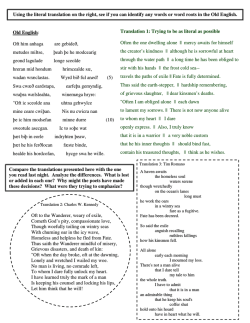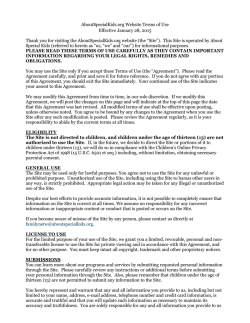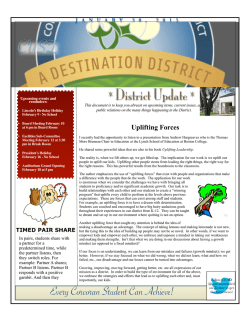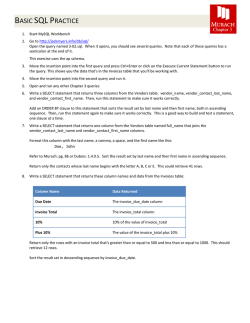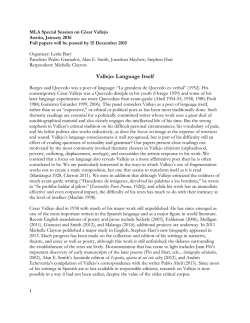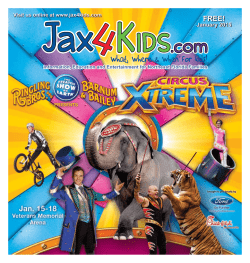
February 2015 - Oraze Elementary School
February 2015 Vol. 26, No. 6 ® Clovis Unified School District make the difference! Historical fiction brings the past to life! Retelling can improve your child’s reading comprehension Y ou’ve just finished reading a story with your child. One of the best ways to check comprehension and boost his understanding of the story is by asking him to retell it. Retelling a story requires your child to think about the details and decide what’s really important. Give your child these three rules for retelling a story: 1. Tell what’s important. 2. Tell it in a way that makes sense. 3. Don’t tell too much. Your child should be able to tell you what happens at the beginning, the middle and the end of the story. He should also be able to name the main characters. You can prompt your child by asking open-ended questions, such as, “What happened next?” It’s okay if your child doesn’t remember all the details. That gives you a chance to say, “Let’s go back and look at that part of the story again.” Revisiting parts of the story will show your child that he sometimes has to read things more than once to gain a thorough understanding. Studies show that this simple activity will help your child become a more thoughtful reader. He will start to pay attention to words whose meanings he doesn’t know. He will focus on the story structure and pay more attention to important details. All of these things will improve your child’s reading comprehension and make him a better reader—and a more successful student! Source: B. Taylor and J. Ysseldyke, Effective Instruction for Struggling Readers: K-6, Teachers College Press. History can be fascinating. But reading about it in textbooks can sometimes seem dull and dry. That’s where historical fiction can come in. The best historical fiction brings a past time to life. It shares the details about what people wore, what they ate and how they really lived. It gives the reader a vivid glimpse of history. For the best experience with historical fiction, here are things to keep in mind: • Ask a children’s librarian to suggest a book that presents history accurately and avoids myths or stereotypes. • Look for a book with illustrations. This is when a picture really is worth a thousand words. • Try reading the book aloud if it is a little challenging for your child. • Read more than one book about the same period. Talk about how people see the same event differently. Source: E. Codell, How to Get Your Child to Love Reading, Algonquin Books of Chapel Hill. 333333333 Copyright © 2015, The Parent Institute® www.parent-institute.com Practical ideas for parents to help their children Copyright © 2015, The Parent Institute® www.parent-institute.com Share poetry with your child to Are you teaching build language and writing skills your child how Reading poetry together is a great way to make your child more aware of language. Poetry will help her develop better writing skills and introduce her to new and different words. (It’s not just black, it’s ebony.) Here are some strategies for sharing poetry with your child: • Read widely. Children love Dr. Seuss and Shel Silverstein. But there are many more poets to enjoy. Look for a collection of children’s poetry in your local library. Or ask your child’s teacher to recommend some good poetry books. • Don’t read too fast. Let your child listen to each word. • Talk about the words poets use. In “Paul Revere’s Ride,” Longfellow speaks of “the hurrying hoof-beats of that steed.” If your child doesn’t know what a steed is, this is a good chance to find out! • Have fun! Your enthusiasm will carry over to your child. • Start a poetry notebook. Let your child copy down favorite poems (or parts of longer poems). Underline words or phrases she especially likes. Then she can go back and reread these poems on her own. Source: T. Thomason and C. York, Write on Target: Preparing Young Writers to Succeed on State Writing Achievement Tests, Christopher-Gordon Publishers. “Poetry is when an emotion has found its thought and the thought has found words.” —Robert Frost Three activities can help your child master math vocabulary When children learn math, they also need to learn a whole new vocabulary. If they have to stop to think about words like product or quotient, they won’t be focused on doing the math. Just as your child needs to commit basic math facts to memory, he also needs to know many math terms. So make a game of learning them. Here are three activities to try with your child: 1. Play math concentration. Write a math term on an index card. Write its definition on another card. Then deal out five or six pairs of cards face down. Your child can only turn over two cards at a time. The goal is to make a match by turning over a math term and its correct definition. 2. Link math symbols to math words. Have your child create flash cards with a symbol on one side and the word it represents on the other. Use the flash cards to help your child review. 3. Create memory aids that show a term doing the thing it represents. The math term circumference, for example, is the distance around the edge of a circle. So your child could write the word circumference around the edge of a circle. Source: J. Willis, How Your Child Learns Best, Sourcebooks. 2 • Elementary • Parents make the difference! • February 2015 to prioritize? Prioritizing is a tall order for many children. What is the main thing they need to do? How can they focus on that? Are you helping your child learn to put first things first? Answer yes or no to the questions below to find out: ___1. Do you encourage your child to write down her assignments every day—from tomorrow’s math homework to next month’s science project? ___2. Have you explained that your child’s top priority should be anything that is due tomorrow? ___3. Do you help your child decide what to do first if several things are due at the same time? ___4. Do you encourage your child to complete a small part of a longterm project each day? ___5. Do you enforce rules about what your child has to finish before she is allowed to watch TV or play outside? How well are you doing? Each yes means you are helping your child prioritize. For each no answer, try that idea in the quiz. ® make the difference! Practical Ideas for Parents to Help Their 1523-1275 Children. ISSN: 1046-0446 For subscription information call or write: The Parent Institute®, 1-800-756-5525, P.O. Box 7474, Fairfax Station, VA 22039-7474. Fax: 1-800-216-3667. Or visit our website: www.parent-institute.com. Published monthly September through May by The Parent Institute®, a division of NIS, Inc., an independent, private agency. Equal opportunity employer. Copyright © 2015 NIS, Inc. Publisher: Phillip Wherry. Editor: Rebecca Hasty Miyares. Illustrator: Joe Mignella. X02594459 www.parent-institute.com Copyright © 2015, The Parent Institute® Teach your child to review tests and learn from mistakes Your child brings home a test with a disappointing grade and wants to throw it away. What should you say? “Everyone makes mistakes, but not everyone learns from them.” Help your child review the test, learn from mistakes and raise her odds of future success! Here are some common mistakes students make: • Careless errors. Sometimes students record wrong answers accidentally. “Oops! I meant to circle A, not B!” Other times they misread something, skip a question or simply have poor handwriting. • Lack of preparation. Paying attention in class is a great first step. But kids also need to read textbooks, complete homework, memorize facts and ask questions when they’re confused. • Poor habits. Perhaps your child stayed up late the night before the test and didn’t get enough rest. Maybe she skipped breakfast and found it hard to concentrate. Help your child find solutions for any problems that occurred. Could she read tests more carefully next time? Study with flash cards? Go to bed on time? Also focus on what your child did well! She probably answered many questions correctly. Then, as you read over the test, help her understand what she did wrong and encourage her to fix each of her mistakes. Source: R. Fry, “Ace” Any Test, Thomson Delmar Learning. Take responsibility for learning with a ‘think-through’ sheet Your child has to learn many important things in elementary school. But perhaps the most important thing he can learn is how to take responsibility for his own learning. A “think-through” sheet can help your child accomplish this. Here’s how it works. Have your child: 1. Divide a sheet of paper into three columns. 2. Label the first column “I have to.” Label the second column “Do I know how to?” and the third, “Where can I get help?” 3. Write the things he has to do for homework in the first column. For example, his list might include, “Multiply two-digit numbers in math” and “Write a book report.” 4. Fill in the second column. Does he know how to multiply twodigit numbers? If the answer is yes, then he can go ahead and do the math problems. If the answer is no, he needs to move on to the third column. 5. Think about where he can get help if he doesn’t feel confident. Should he look back in his math book? Can he check with a friend? Should he ask the teacher for extra help? Have him write down all of his options. Using this type of checklist will help your child see that there are things he can do when he’s stuck. Over time, he will actually gain a better sense of how he learns best. Source: R. Flippo, Texts and Tests: Teaching Study Skills Across Content Areas, Heinemann Publishing. Q: There are some mean kids in my son’s class. One of them is picking on another student. I found out that although my son is not the bully, he stands by as these things are happening. What should I do? Questions & Answers A: Children who are bullied aren’t the only ones who are affected. Children who witness repeated incidents of bullying can be affected, too. Standing by and doing nothing hurts onlookers’ self-confidence and self-respect. Even if your son wants to help the victim, he may fear getting hurt or becoming a target of the bully himself. He may not want to be labeled as a “snitch.” Or, he simply may not know what to do. Your job is to give your child the power to do what he knows is right. Here’s how: • Have a casual talk about school. “I hear some students are being mean to Daniel. Have you ever seen anything like that go on?” • Talk about your family’s values. Tell your child, “I know you’d like to stop this from happening, and you can.” • Encourage him to tell a teacher. He might say, “You should check out the bathroom on the second floor after lunch. Please don’t tell anyone I told you.” • Encourage him to talk to his other friends about what’s going on. Together, they might distract the bully: “Hey, we’ve got some work to do—let’s get back to class.” Or they can just say, “Cut it out. It’s not cool to pick on people.” • Suggest that he seek out the victim later to offer his support and friendship. February 2015 • Elementary • Parents make the difference! • 3 Copyright © 2015, The Parent Institute® www.parent-institute.com It Matters: Motivation Should you pay your child for good grades? You’re worried about your child’s grades. Then he makes a suggestion: “I would do better if you paid me for every good grade I bring home.” Should you get out your wallet? No, say most experts on motivation. Here’s why paying kids for good grades is not an effective motivator: • It places the emphasis on the wrong thing. If you promise your child money for a good grade, he’ll be working for the money rather than working to learn. He may find that he wants the money so badly that he’s even willing to cheat to get it. • It doesn’t help your child learn the satisfaction of doing a job well. Children need to learn the joy that comes just from doing something to the best of their ability. Great pride comes with handing in one’s best work. That is the reward your child ought to be striving for. • It focuses on the outcome rather than the effort. Children need to learn the importance of trying their best and sticking with challenging subjects. Putting all his attention on a reward at the end of the process will make it harder for your child to learn that lesson. So what should you do? Let your child know that school is important. Celebrate his successes with time spent together. And keep your money in your pocket! Source: M. Flannery, “Cash for Grades?” National Education Association, niswc.com/cash_grades. Build your child’s enthusiasm about school and learning A child’s experiences at school affect her attitude about learning, and so do her experiences at home. To build your child’s enthusiasm for education: • Be a role model. If you have a positive attitude about school, your child is more likely to feel the same way. In addition to saying good things about school, attend school meetings, parentteacher conferences and other school events. Supervise your child’s homework time and show interest in her school day. • Compliment success. When your child works hard, be sure to speak up! This helps her make a connection between effort and feeling good about her success. • Link lessons to real life. Show your child how what she learns at school can help her in real life. Math skills may help her spend money wisely and understand sports statistics. A vocabulary word may show up in a favorite movie or book. A ‘growth mindset’ will help your child tackle challenges School is filled with challenges—and your child’s success depends on how he responds to those challenges. Encourage your child to develop what researchers call a growth mindset. A growth mindset affects how kids think about problems. Suppose, for example, your child is having trouble finding the answer to a math problem. Some kids would throw up their hands. “I’m not good at math,” they’d say as they quit trying. But 4 • Elementary • Parents make the difference! • February 2015 other kids would take another view. “This is a challenge and I love a challenge.” Children in the second group have a growth mindset. They believe that even if they can’t do something now, they will be able to learn it in the future. They’re more likely to stick with the problem— and solve it. You can encourage this mindset by praising your child’s effort. “That project was challenging, but you stuck with it and finished it!” Source: M. Krakovsky, “The Effort Effect,” Stanford University, niswc.com/growth_mindset.
© Copyright 2025
